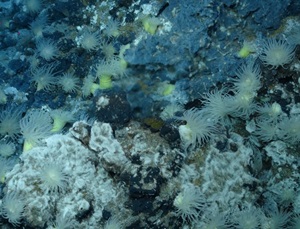When reading the words deep sea mining, what goes through your mind? Maybe it’s the first time that you have come across these words and wonder: what is it all about?

Here I will explain what is meant by deep sea mining by drawing on the findings of a Royal Society report on future ocean resources. In particular, I will focus on the process of regulating this potential new industry and the objective of the Royal Society’s involvement with an important UN meeting on mining regulation in Jamaica earlier this year.
Renewed interest in deep-sea mining
The concept of harvesting minerals from the deep ocean floor isn’t new, but has received renewed attention and interest in the last decade. Deep sea mining was first discussed in the 1960s, but it quickly became clear that recovering metal minerals from several thousand metres below the ocean surface, would face insurmountable challenges of a technological, economic and environmental nature. However, over the last decade renewed interest in deep sea mining has come from governments, policymakers, researchers, investors and mining companies.
What has sparked this change? Minerals are vital for the functioning of modern society. We are using them in ever greater quantities and in an increasingly diverse array of applications, from mobile phones to electric vehicles. The rise in metal demand combined with complexity of sourcing minerals from countries that are not always politically stable has led to increased concern around mineral resource security. This increased demand for minerals, and potential for higher prices, has led the minerals industry to consider more extreme and technically challenging environments, including the depths of the ocean.
Where can we find ‘deep-sea’ minerals?
This potential resource exists across the global oceans, both within and beyond national jurisdictions and interacting with many different ocean ecosystems. These interacting constraints can be explored on the Royal Society’s interactive future ocean resources map. The extent of the impact that mining would have on these ecosystems is yet to be fully explored, but the latest research suggests that environmental impact of deep-sea mining is likely to be significant.
Who do these mineral resources belong to?
Fifty years ago, the international community, through the United Nations, took a decision to set aside the resources of the seabed, beyond an individual nation’s jurisdiction, as the common heritage of mankind. Its administration was placed in the hands of an international organisation, the International Seabed Authority (ISA). So rather than seabed mineral resources being open to all, without restriction, access is permitted only under a contract with the ISA, under strict conditions.
How to regulate this emerging industry?
Regulating the exploitation of resources that are very difficult to access, resources that typically support local and regional biodiversity, and considered as common heritage of mankind, is not a straightforward task. Not only do the regulations have to define rules for how mining will happen in practice, they also need to specify how to share the benefits resulting from the exploitation of the minerals, and what the penalties should be in case the rules set by the ISA are not followed.
Developing good regulation requires the provision of the best available evidence and the involvement of all those who might be involved or affected by the practices to be regulated. For this reason, the Royal Society hosted, together with the UK Foreign and Commonwealth Office (FCO), a two day workshop in February 2018, bringing together experts from science, civil society and industry as well as delegates from ISA Member States and international organisations. Our aim was to identify important issues that should be addressed in the development of the mining regulations and ensure that the best available science is taken into account in this development process.
The workshop was split into two parts. It started with a series of plenary talks by leading experts. The talks provided an update on the draft regulations, a scientific overview of the potential of mineral resources in the deep-sea and practical considerations on environmental assessment and risk management. The second part consisted of break-out sessions where attendees got the opportunity to share their expertise and discuss questions including how to ensure best scientific advice is taken into account in developing and implementing the regulations.
Having gathered crucial input for the development of the regulations, sharing the key findings of the workshop with the ISA Council was the next important step. Dr Chris Hauton with delegates from the Foreign and Commonwealth Office and Royal Society went to the biannual ISA Council meeting held in Kingston, Jamaica. Findings from the workshop were presented to Council members. 140 attendees gave us and the science a warm reception and we were assured that our output would be of great use in the development of the regulations.
Will deep-sea mining ever happen (at commercial scale)?
There is a lot of interest in deep-sea mining. However, does that mean deep-sea mining will happen? That question cannot be answered with absolute certainty at this stage. The current development in key areas (technology, economic viability) suggests that exploitation of minerals from the deep sea could begin within the next ten years. But there are still a number of questions, including scientific ones, which need to be answered before anybody can proceed. Answering those questions and enacting regulation which can accommodate that knowledge before activity begins will be crucial.




